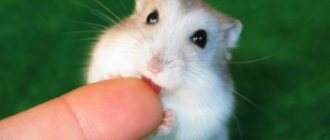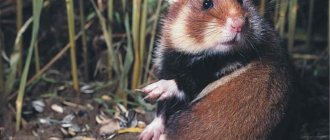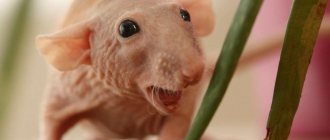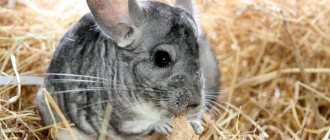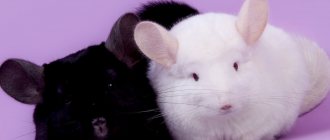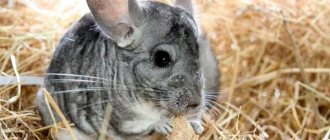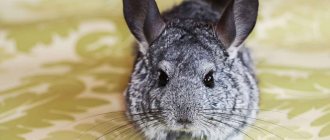In the forests of the wonderful island of Madagascar lives one of the most amazing animals in the world - the little arm, or, as it is also called, the aye-aye. This animal has such an unusual appearance that the natives of Madagascar saw in it a ghost, a fiend of hell, and in general, the source of all their troubles. Having encountered this “terrible” creature, the local population always tried to kill it. As a result of superstitions, and most importantly, due to the destruction of the animal’s habitats, the little arm was on the verge of extinction.
The Madagascar bat (Daubentonia madagascarinensis) is a mammal from the order of primates, a suborder of lemurs, the only representative of the family of bats. This animal was discovered in 1780 by Pierre Sonner, who was engaged in research in the west of Madagascar. He described this creature as a tropical rodent, but later, after long discussions, scientists nevertheless came to the consensus that the aye-aye was not a rodent at all, but a lemur, which, in the course of evolution, deviated somewhat from the general trunk of the group.
What does aye-aye look like? Photo of the hand
The appearance of the arm is unique. The body is covered with shaggy hair of dark brown or black color; long guard hairs have white tips. The muzzle and underbody are lighter – cream or grayish. The tail is longer than the body, very fluffy. The head is quite large, round, with large, leathery, leaf-shaped ears. The large eyes are bright orange or yellow-green and surrounded by characteristic dark circles. The incisors have a structure similar to that of rodents: very sharp, constantly growing. The photo of the little arm clearly demonstrates its bizarre appearance.
The little hand is the largest representative of nocturnal primates. The body length is 36–44 cm, the tail is 45–55 cm, the weight of the animal rarely exceeds 2.5 kg.
Little arms run and jump on four limbs. The fingers and toes are equipped with long, curved claws, except for the first digit of the hind limbs, which has a real nail.
The most notable feature of the hand is the middle finger on the hand. It is incredibly long and thin and has virtually no soft tissue. The animal uses such a tool, coupled with constantly growing incisors, to obtain food: it gnaws holes in dry wood and pulls out insect larvae (photo below). This finger is also used as a drumstick to tap wood to locate the larva. Science knows of only one other mammal that uses such an unusual method of searching for food - this is the New Guinea small cuscus, which belongs to the marsupial flying squirrels.
Nutrition
The little hand is not a predator. It feeds exclusively on insects and their larvae. Living in trees, the animal listens very sensitively to buzzing insects flying past, crickets, caterpillars or worms swarming in the dry bark. Sometimes they can catch butterflies or dragonflies. Larger animals are not attacked and prefer to stay away.
Thanks to the special structure of its front paws, the little arm very carefully taps the bark of trees for the presence of larvae, and carefully examines the branches of the trees on which it lives. The sinewy middle finger is used by the animal as a drumstick, indicating the presence of food.
Then the hunter chews the bark with sharp teeth, takes out the larvae and, using the same thin finger, pushes the food into the throat. It has been officially established that the animal is capable of detecting the movement of insects at a depth of up to four meters.
Loves little arms and fruits. Having found the fruit, she gnaws the pulp. Loves coconuts. She taps them, just like the bark, to determine the amount of coconut milk inside, and then simply chews the nut she likes. The diet includes bamboo and reed. Just like hard fruits, the animal gnaws the hard part and selects the pulp with its finger.
Aye-aye hands have a range of sound signals. With the onset of dusk, animals very actively begin to move through the trees in search of food. At the same time, they make a loud sound, similar to the grunting of a wild boar.
To drive other individuals away from their territories, the little arm can emit a loud cry. He speaks of an aggressive attitude; it is better not to approach such an animal. Sometimes you can hear some sobbing. The animal makes all these sounds in the fight for territories rich in food.
The animal does not play a special role in the food chain of Madagascar. She is not hunted. However, it is an integral part of the island's ecosystem. Interestingly, there are no woodpeckers or birds similar to them on the island. Thanks to the feeding system, the little hand does the “work” of woodpeckers - it cleans the trees of pests, insects and their larvae.
Habitat of the baton
Low population densities make it difficult to observe these nocturnal animals. Therefore, until recently, scientists believed that the bat's habitat was limited to a small area of rain forest on the east coast of Madagascar. Recently, however, aye-ayes have been found in other wooded areas along the entire east coast, as well as in wet forests in the northwest and even in deciduous forests on the west coast. The little beetle is not strictly confined to primary forests. It can also be found in mangroves and coconut plantations.
Description of the species
The Madagascar bat (Daubentonia madagascariensis) is the only living representative of the family of bats.
The creature looks unusual: brown fur, a long tail, thumbs and crazy eyes. The little hand is considered one of the large nocturnal primates. Scientists classify this species as a lemur.
Pic by Duke Lemur Center / Caters
For the inhabitants of Madagascar, these animals are sacred creatures. There are legends that whoever kills an animal will soon die himself.
The weight of the aye-aye is 3 kg, the length of the tail is 6 cm, and the entire body is 3644 cm, depending on the age of the primate. Large eyes, most often yellow, and huge ears distinguish the little monkey from other species.
It is interesting that the animal is fluffy, however, its paws are without hair. The limbs look like human hands, even have fingers. It was this fact that prevented scientists from deciding which family to assign the discovered species to.
Aye-aye lifestyle
The little hand leads an exclusively nocturnal lifestyle. She spends the day in a nest, which she builds herself from branches and leaves at a height of 10–15 m above the ground. It takes about a day to build a nest. Each animal uses several nests in a certain order, and different individuals rest in one nest every day. The aye-aye prefers to move along tree branches, but can descend to the ground to cross a forest clearing.
Little hands lead a predominantly solitary lifestyle. In places where food is abundant, several individuals can gather at once, but females are usually intolerant of each other's presence.
Each individual has an individual plot, the area of which is often more than 30 hectares. With the help of scent marks, urine and screams, little arms claim rights to their territory. The feeding areas of males overlap with those of females.
The main diet of the hand-footed insect is insect larvae and the soft contents of fruits. Aye-aye is a frequent visitor to coconut palm plantations. Before gnawing through a coconut shell, the animal taps the fruit to assess whether it contains a lot of milk.
It is not known exactly how long bats live in nature, but in zoos their lifespan is quite long - up to 26 years.
Baby monkey born at San Diego Zoo
Interesting facts about the animal
- The little hand knocks on the trees about eight times per second. She spends about 40% of her time searching for food.
- The animals begin looking for food three hours after sunset and spend about 80% of the night time searching for larvae in tree trunks.
- Ai-Ai are having an interesting holiday. Climb a tree using vertical jumps. They go down to the ground if necessary. They mostly jump from tree to tree. At night, they jump over distances of up to 4 km.
- Females are dominant over males. They are not monogamous. In addition to mating, they can interact when feeding the cub.
Reproduction of Madagascar monkeys
Females become capable of reproduction only once every 2-3 years, and in any season, which is uncharacteristic for lemurs. The female announces her readiness to mate with loud cries and mates with all the males who come to her call.
Pregnancy lasts 170-172 days, after which one single baby is born. The female arranges a cozy nest for the newborn, which the cub does not leave for about two months. The little hand feeds on mother’s milk for at least 7 months, but even after switching to “free bread”, it stays close to its mother for about a year and a half. The animals reach sexual maturity at 2-3 years.
Preservation of the Madagascan handwort in nature
The little hand is endangered and is listed in the Red Book. The survival of these lemurs in nature is threatened primarily by deforestation. Considerable harm is also caused to the species by superstitious people who consider aye-ayes to be harbingers of death and try to kill them when they meet them. They also suffer from farmers whose plantations are raided by these animals.
At one time, the bat was even considered one of the rarest mammals in the world.
Fortunately, research in recent years has shown that the aye-aye is more widespread than previously thought, and the total number of aye-ayes is even greater than the number of some species of lemurs. Significant efforts aimed at preserving the species give us some hope that such an unusual animal will continue to exist on planet Earth.
Share with your friends:
Where can residents of Russia see it in captivity?
Popular news about the animals of the Moscow Zoo are news about the birth of new babies and the addition of new exotic animals to the zoo. Some of the most popular news about animals at the Moscow Zoo includes news about Madagascar bats.
Zoo managers have been negotiating for a long time with Darella Park, located on the Channel Islands, about transferring small lemurs - Aye-Aye - to Russia. At the zoo, many animal fans will rejoice at the small, unusual animals.
Little arms are not born in captivity. However, a rare species of lemur called Aye-Aye was born in captivity in England for the first time. Veterinarians give a positive prognosis about his health.
Notes
- ↑ Gladkova T. D. Primates squad // Animal life. Volume 7. Mammals / ed. V. E. Sokolova. — 2nd ed. - M.: Education, 1989. - P. 129-130. — 558 p. — ISBN 5-09-001434-5
- ↑ Jolly E., Albignac R., Petter J.-J. Lemurs // Madagascar (Series: Golden Fund of the Biosphere) / trans. from English, scientific ed. B. D. Vasiliev, resp. ed. series by V. E. Sokolov. - M.: Progress, 1990. - P. 242-243. — 296 p. — ISBN 5-01-002049-1
- ↑ Biological encyclopedic dictionary / Ch. ed. M. S. Gilyarov; Editorial team: A. A. Baev, G. G. Vinberg, G. A. Zavarzin, etc. - M.: Sov. encyclopedia, 1986. - P. 549. - 831 p. — 100,000 copies.
- ↑ Sokolov V. E.
Five-language dictionary of animal names. Mammals. Latin, Russian, English, German, French. / under the general editorship of academician. V. E. Sokolova. - M.: Rus. lang., 1984. - P. 84. - 10,000 copies. - ↑ Fisher D., Simon N., Vincent D. The Red Book. Wildlife in danger / trans. from English, ed. A. G. Bannikova. - M.: Progress, 1976. - P. 50-54. — 478 p.
- "Big Encyclopedia" ed. Yuzhakova, 1901-1909.
- ↑ “Dictionary of modern Russian literary language” in 20 volumes, vol. 1, 1991.
- Bo Beolens, Michael Watkins, and Mike Grayson.
The eponym dictionary of mammals. - Baltimore: The Johns Hopkins University Press, 2009. - P. 101. - 574 p. — ISBN 978-0-8018-9304-9. - Vasiliev D. B.
Afterword // Madagascar / Rep. ed. series by V. E. Sokolov. - M.: Progress, 1990. - (Golden Fund of the Biosphere). — ISBN 5-01-002049-1.. — P. 276.
Tarsier
Many have heard that there is a small animal that lives in the Philippines and is famous for its unusually large eyes. In its homeland it was called “tarsier”. Among mammals, it ranks first in terms of the ratio of eye size to body size. Thanks to this, he was included in the Guinness Book of Records. This small animal with large eyes has a body weight of only 134 grams. Females weigh even less - only 117 grams. Accordingly, they have a small body size, which usually ranges from 10 to 15 centimeters. But their eyes are surprisingly large, and each of them weighs more than the animal's brain. If a person had the same height-to-eye ratio, it would look as if we had grapefruits inserted into our eye sockets.
The tarsier is nocturnal. He navigates very well in the dark, and he is also able to see ultraviolet light. But this baby cannot distinguish colors. The animal is not dangerous to society, but on the contrary, eats various insects and worms. If someone manages to tame it, the tarsier will turn out to be a good assistant to its owner in exterminating parasites. But this cute animal with big eyes has great difficulty getting used to a person and may not get along with him. So, the diet of this big-eyed bird includes spiders, small vertebrates, lizards and insects. To feed, the baby grabs the victim with both paws and does not let go. Interestingly, tarsiers can turn their necks 360°, and this fact used to frighten local residents very much, who thought that the head of these animals was separated from the body.
Chinchilla
The animal is a native American inhabitant of the order of rodents. It is difficult to spot the animal in the wild; their population is small and lives in the mountains. Because of their incredibly soft and beautiful skin, chinchillas were practically exterminated back in the 19th century.
The animal has a round head on a short neck, long whiskers (up to 10 cm) and round, large ears (up to 5 cm). There is a membrane in the concha of the ear that covers the ear canal when the chinchilla bathes in the sand. It grows in length up to 25-35 cm with a tail up to 15-20 cm, weighs slightly less than a kilogram. The animal is very flexible and can crawl into the smallest gap. The presence of long, strong hind legs (2 times larger than the front ones) allows him to make high, two-meter jumps.
Nowadays, the rodent has gained popularity as a pet. It is recommended to keep him in a spacious cage or enclosure and, after getting used to it, let him out for indoor walks.
They actually exist
Meanwhile, zebroids actually exist. This is a hybrid of a horse and a zebra. As a rule, a horse is the mother of such a foal, and a zebra acts as its father.
The zebroid or zorses, as they are called in the English-speaking world, is an unusually beautiful and interesting animal.
From zebras, such hybrids inherit a wild, freedom-loving disposition and a proud, independent character. However, hybrids also get the curiosity and wariness inherent in zebras.
Zebroids take all the best from horses, from color to qualities such as loyalty, friendliness, intelligence, and endurance.
Millions of people find peace of mind in parked cars during quarantine
Richard Gere and his wife celebrated their wedding anniversary and showed archival photos
Adele returns: the singer is back on social networks and thanks health workers
Zebroids are not rare animals at all, but practically nothing is known about them in Europe. But in Africa they are specially bred, just like ordinary horses.
Hybrids have been used since ancient times as “trekking animals”, that is, they transport people and various not particularly heavy or bulky cargo through “hard”, complex landscapes.
Zebroids are much hardier than ordinary horses, they require much less water, and they can feed on almost anything they can find under their feet. In addition, hybrids have better health, they practically do not get sick.
Apocalypse in reality. A powerful sandstorm covered the capital of Niger: video
50 Shades of Dakota Johnson: the actress presents the new film “Assistant to the Star”
Talk about him with friends: how a girl can develop a sense of masculinity in a guy
Who is she - a rodent or a lemur?
The taxonomy of the Madagascar aye-aye has been repeatedly questioned: there have been long scientific debates about the place of the aye-aye in zoology. For example, its peculiar structure of teeth and squirrel tail indicated that the little arm should be classified specifically as a tropical rodent. So it was, but not for long. Scientific debate regarding the classification of this animal flared up constantly.
As a result, the scientists agreed that the Madagascar little lemur (photo No. 2) is not a rodent, but a real lemur, albeit somewhat deviated in development from the general trunk of its group. By the way, the name of the subfamily (genus) of these animals was given in honor of the French naturalist Louis Jean-Marie Daubanton, who lived in 1716-1800.
